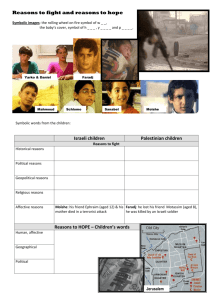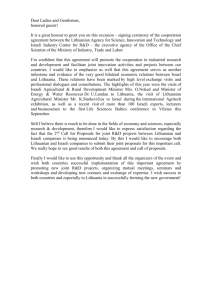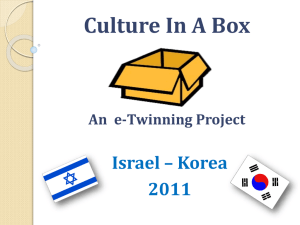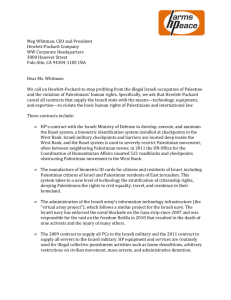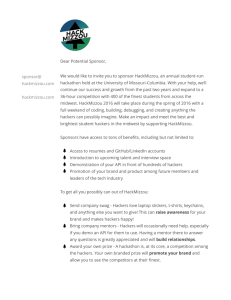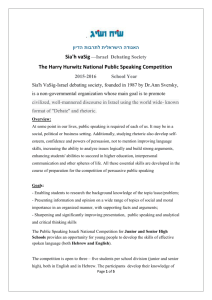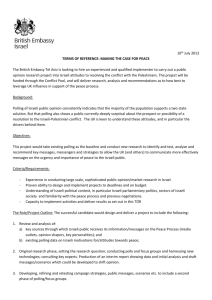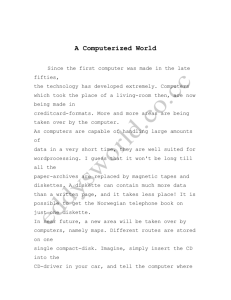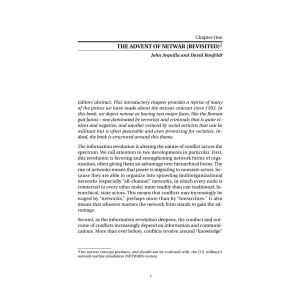Cyberconflict
advertisement
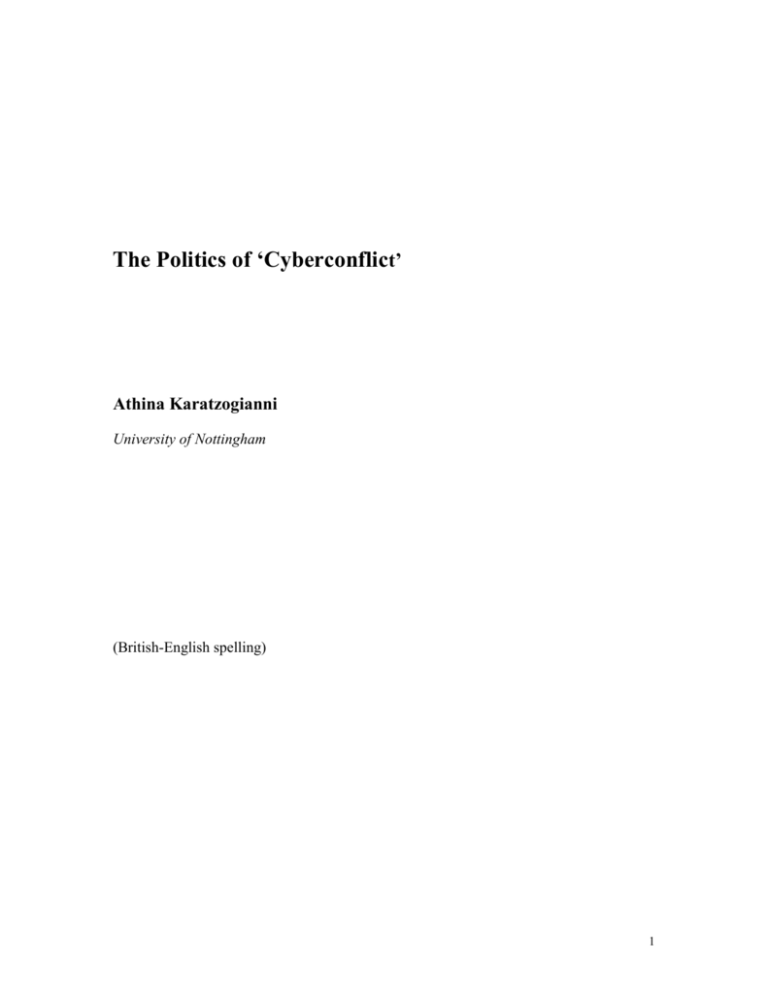
The Politics of ‘Cyberconflict’ Athina Karatzogianni University of Nottingham (British-English spelling) 1 The Politics of Cyberconflict The turn of the century witnessed the emergence of a new kind of conflict named ‘cyberconflict’ to mean conflict in computer-mediated environments (cyberspace). This article seeks to introduce the key terms and themes of cyberconflict and argue that two different trends occur: one between ethnic or religious groups fighting over in cyberspace, as they do in real life and second, between a social movement and its antagonistic institution (hacktivism). 2 Introduction The political use of the Internet has created a new lexicon, spawning terms like “cyberwar”, “cyberattack” and “netwar”. “Cyberconflict” (CC)– the generic reference to a certain form of politics on the Internet - is now in regular use, but it has not yet been sufficiently clarified. This is because there are problems in defining and categorising the wide variety of events occurring in cyberspace that fall under this conceptual umbrella. Here, the term cyberconflict is used to refer to conflicts of the real world spilling over to cyberspace. Typical of cyberattacks in the use by opposing parties of either Information Technology as such or IT as a weapon - for example worms1, Distributed Denial of service attacks (DDos)2, Domain Name Service attacks (DNS)3, or unauthorised intrusions4 - to attack the other side. The argument of this paper is that cyberconflict includes two different categories of cyberpolitical action, which are sometimes blurred. The first is between two ethnic or religious groups that fight it out over in cyberspace, as they do in real life, and the second is between a social movement and its antagonistic institution. Theoretical basis The political environment of the Internet is analysed here not in terms of the Internet as a mass medium in the traditional sense (i.e. what would be an Internet News bureau’s or the online version of an already established medium’s influence on the political outcome of a conflict), but rather as a significant new resource used by the opposing parties in a 3 conflict. This presents us with a major theoretical challenge: There is no theoretical model to date that can provide us with the conceptual tools to analyse the use of the Internet by the actual parties in the conflict (endogenously) and not just theorise about the way in which the media influence - or not - the political outcome of a conflict (exogenously). The reason for this is that the Internet is not a traditional medium, access to which groups, institutions, or states compete. It can be used by anyone, at any time, from any place on the planet. Furthermore, despite the fact that actors using the Internet might still seek traditional political goals like power, participation or democracy, the postmodern nature of the medium makes a more complex theoretical approach compulsory. Explaining cyberconflict in a single framework, for instance a media studies approach, a conflict theory or even a social movement approach like the resource mobilisation theory (RMT), would provide us with a one-dimensional and inadequate discussion. The interest lies in introducing this phenomenon under as many ‘theoretical lights’ as possible and at the same time refrain from being blinded by the radiance of the novelty of the medium itself. One of these theoretical lights is Gadi Wolfsfeld’s political contest model. His work Media and Political Conflict (1997) is a way of looking at the role of the media in political conflicts by building what he calls the political contest model. According to Wolfsfeld, the best way to understand the role of the news media in political conflict is ‘to view the competition over the news media as part of a larger and more significant contest among political antagonists for political control’ (p.3). However, the true relevance of his work to cyberconflict can be drawn from his discussion of the three 4 variables that constitute the ability of the antagonist to control the political environment, which in turn increase the ability of an antagonist to dominate public discourse about a particular issue (p.25). These are the ability to initiate and control; the ability to regulate the flow of information; and the ability to mobilize support. The problem with this though is that Wolfsfeld is talking about ‘real’ political conflicts, where the news media outside the conflict (exogenously) respond to events. However, we are interested in how the parties in a ‘cyberconflcit’ (either socio-political or ethnoreligious and this is where Wolfsfeld’s variables prove helpful for us to understand the differences) use a medium directly (endogenously) without third parties (traditional news media) to influence the political outcome of a conflict. During the course of this discussion examples of cyberconflict will be situated within a modified version of Wolfsfeld’s argument. Netwarriors: Terrorists or Social Activists? It is not surprising that the Internet has been used vigorously by social activists and campaigners all over the world. The Internet quickly puts information into the hands of organisers, allows rapid replication of a successful effort, allows users to select their level of activity and helps publicise the campaign. It is therefore an organising tool par excellence, because the more traditional telephone trees or fax machines are two slow and the physical distances are too difficult and too expensive to cover (Danitz and Strobel, 2001, p.162). However, the Internet is not only used by social activists. An examination of historical precedents indicates that major political and military conflicts are 5 increasingly accompanied by a significant amount of online aggressive activity. Ongoing conflicts also show that cyberattacks are escalating in volume, sophistication and coordination (Vatis, 2001). Parties in cyberconflicts have been described as terrorists or social activists depending on the discursive mood of their critics. This is why it is important to examine the politics of this phenomenon and understand its implications for future conflicts. Arquilla and Ronfeldt (2001) differentiate between the terms ‘cyberwar’ and ‘netwar’. While cyberwar refers to a more "heavy" mode of new military conflict like destruction of the enemy’s infrastructure through information technology, the term netwar was devised to refer to information age conflict at the less military, low intensity, more social end of the spectrum. According to these writers, there are roughly two categories of netwarriors: those who are violent and negative, i.e terrorists and criminals, or social activists, who maybe militant but can be also peaceable and even promising. One of the interesting sides to their argument is that the information revolution is altering the nature of conflict by strengthening network forms of organisation over hierarchical forms. The network form of organisation could also be described as the rhizome (Deleuze and Guattari, 1987). In their work A Thousand Plateaus they argue against a world where ‘the tree is already the image of the world or the root the image of the world tree’ (p.5). Instead they prefer to explain the world with principles of connection, heterogeneity and multiplicity, where ‘any point of a rhizome can be connected to anything other, and must be’ (p.7). In this vain, a rhizome establishes connections between semiotic chains, 6 organizations of power and circumstances relevant to the arts, sciences and social struggles. Based on this rhizomatic conceptualisation of the world, the Internet is a typical rhizomatic structure and the groups using it are rhizomatic in character because they seem to have no leader, coming together for an event (for example anti-globalisation protests or hacking enemy web sites) and dissolving again back to their own ceaselessly changing line of flight into the adventitious underground stems and aerial roots of the rhizome. Deleuze and Guattari might have been easily be speaking about the Internet when they wrote: To these centred systems the authors contrast acentred systems, finite networks of automata in which communication runs from any neighbour to any other, the stems or channels do not pre-exist, and all individuals are interchangeable, defined only by their state at a given moment -such that the local operations are coordinated and the final, global result synchronized without a central agency (p.17) Following that argument, Arquilla and Ronfeldt go on to say that hierarchies have a difficult time fighting networks (e.g. Colombia, Algeria, Zapatistas). It takes networks to fight networks and whoever masters the network form first and with the most success will gain major advantages (Arquilla and Ronfeldt, p.55). Moreover, it would be useful to stress that terrorists might be more interested to keep the Internet up and running than to disrupt or destroy its components. One has to agree with 7 Arquilla and Ronfeldt that networked based conflict will become a major phenomenon of the future and this can be clearly demonstrated with Al–Qaeda even long before the September 11th attack with reports of Bin Laden having advanced information systems designed by Egyptian computer scientists.5 As Arquilla and Ronfeldt (2001) argue: These protagonists are likely to consist of dispersed small groups who communicate, co-ordinate and conduct their campaigns in an internetted manner, without a precise central command….To give a string of examples, netwar is about the Middle East’ s Hamas more than the Palestine Liberation Organisation (PLO), Mexico’s Zapatistas more than Cuba’s Fidelistas, and the American Christian patriot movement more than the Ku Klux Klan. (p.45). Hamas in the United States uses Internet chat rooms and e-mails to co-ordinate their activities across Gaza, the West Bank, and Lebanon, making it difficult for Israeli security officials to trace their messages and decode their contents.6 In a 1998 US News and World Report there was evidence of 12 of the 30 groups on the US State Department’s list of terrorist organisations on the Web. More recently, it seems that virtually every terrorist organisation is on the Internet (Denning, 2001, p.252). Another report released on May 1999 from the Rand Corporation concluded that there will be a new form of terrorism known as ‘netwar’: 8 The rise of networks is likely to reshape terrorism in the Information Age and lead to the adoption of netwar- a kind of Information Age conflict that will be waged principally by nonstate actors. There is a new generation of radicals and activists who are just beginning to create Information Age ideologies. New kinds of actors, such as anarchistic leagues of computer- hacking ‘cyboteurs’ may also partake of netwar (Verton, 1999). The report also predicts that cyberterrorists will use new tactics such as ‘swarming’, which occurs when members of a terrorist group, spread over great distances, electronically converge on a target from multiple directions, a tactic different from the traditional form of attacking in waves, which delivers a knock out blow from a single direction on the Internet7. Cyberconflict: The socio-political dimension. Netwar conflicts can be placed into two broad groups, either those who are primarily concerned with global issues such as the environment, issues for which the level of negotiation with governments is open for debate, and those groups who are much less inclined to negotiate with governments, being as they are concerned with issues such as their own liberation from the control of the state (Arquilla and Ronfeldt, 2001, p.15). The 9 main purpose of these activists is to influence or challenge public opinion, or the enemy and battle for media access and coverage. There is a debate between hacktivists concerning denial of service attacks and web defacements. On the one side there are those who find that such actions run contrary to other people’s right to freedom of speech and those who view these actions as the only way to get the public’ s attention. The fact is that Web defacements cannot be dismissed as electronic graffiti and denial of service attacks as nuisances, because there is concern by online companies that it could affect share prices, earning and cause damage to reputation and customer confidence. Indeed this is the reason why there should be more analysis on the reasoning underpinning hacktivism and its political rationale. Tim Jordan writes that social activists or hacktivists have found two uses for the Internet: Mass Virtual Direct Action (MVDA) and Individual Virtual Direct Action (IVDA) (Jordan, 1001, p.8). According to Jordan, MVDA involves the simultaneous use by many people of the Internet to create electronic civil disobedience8. There are two characteristics of this type of hacktivism: First, hacktions are not aimed at halting a target permanently, but have symbolic dimensions. Second, MVDA activists rarely try to hide their identities, seeking public debate and discussion. Individual Direct Virtual Action differentiates from MVDA in that it could be taken by an individual and does not depend on a mass protest. The actions taken are either semiotic attacks (i.e. defacements), computer intrusion or network security. 10 An example of hacktivism would be the Seattle anti-WTO protests at the end of November 1999, which were the first to take full advantage of the alternative media network via the Internet. Protestors used cellphones, direct transmissions from independent media feeding directly onto the Internet, personal computers with wireless modems broadcasting live video, and a variety of other network communications. During the anti-WTO protests, hackivists managed to acquire the URL www.gatt.org, using the GATT address for a parody WTO site, looking identical to the original WTO one, but included a text criticizing WTO trade policies. Another famous hacktion was a MVDA by the Electrohippies, which included a virtual sit-in with a downloadable web page aiming to flood the WTO’s server. The Electrohippies claim that 400,000 hits in this MVDA had slowed down the WTO and at times completely halted it (Jordan, 2001, p.8). Coming back to Wolfsfeld’s three variables, the anti-WTO protesters were able to initiate a newsworthy event, putting the other side to the defensive. Using the Internet they could send stories directly from the street for the whole world to see, rendering the information uncontrollable. Thirdly, they were able to mobilize support by promoting an alternative frame for the event. 11 Cyberconflict: The ethno-religious dimension. The increasing importance of cyberconflict is even more evident when it reflects conflicts belonging to the real world. In October 2000, Israeli and Palestinian hackers engaged in adversial hacking when the prolonged peace talks between the two parties broke down. Until the beginning of November 2000 groups supporting either side in the conflict limited their online activities to defacements and denial-of-service attacks against websites affiliated with the Palestinian movement or Israeli nationalists. One example was when an Israeli flag, Hebrew text and a piano recording of ‘Hatikva’, the Israeli national anthem, appeared on the Hezbollah home page (Hockstader, 2000). Also, Palestinian hackers created a web site called Wizel.com - a host for FloodNet attack, which reloads a targeted web page several times, rendering the site inoperable. The reaction was a sustained counterattack from Pro-Palestinian “cybersoldiers” from the US. The web sites of the Israeli Army, Foreign ministry and Parliament among others were attacked. Targets included financial institutions; e-commerce sites crashed and there was an economic impact reflected in the Israeli stock market. The situation however escalated in the first days of November 2000, when an anti-Israeli hacker attacked the website of one of Washington’s most powerful lobbying organisations, the American-Israeli Public Affairs Committee (Aipac).9 What distinguishes this cyberconflict from past ones is that it has moved beyond being a game controlled by a few highly-specialised hackers into a full-scale action involving 12 thousands of Israeli and Arab youngsters sending racist and occasionally pornographic emails to their opponents while circulating for their supporters a range of Website addresses with simple instructions for how to crush the enemy’s electronic fortresses (Hockstader, 2000). One site offered a menu of targets to attack, including the sites of Hezbollah, the Palestinian national Authority, Hamas and a dozen others. The site encouraged users to click on the targets they would like to disable and offered a set of simple instructions for executing the assault. The whole process did not take more than a minute or two and generated multiple and high speed attacks. IDefense’ s director of intelligence production Ben Venzke thinks that the Palestinians won this particular battle in cyberspace, because according to him, there are people on the Palestinian side trying to learn how to hack overnight to join the effort (Hershman, 2001). The political crisis in the beginning of 2002 in the Middle East spawned again an increase in defacement attacks on Israeli Web servers. Israel was the victim of 10 out of 15 significant web defacements in the Middle East over the first two weeks of April 2002 according to security consultancy mi2g.10 Also, sympathizers on both sides of the Kashmir conflict have used cyberattacks to disrupt each other’s computer systems and disseminate propaganda11. In March 2000, the cyberconflict escalated when a group of Pakistani hackers defaced 600 websites and temporarily took over government and private computer systems. The majority of the 13 sites were hacked after the Pakistanis broke into IndiaLinks, India’s largest Internet service provider12. Another example is the cyberconflict emerging during an international diplomatic incident. When a US spy plane made an emergency landing on Chinese soil on April 1 st 2001, after colliding with a Chinese fighter jet over the South China Sea, killing the Chinese pilot, Chinese hackers vowed to attack US sites, which led hackers in the US to retaliate13. On May 9th 2001, Chinese hackers boasted they had defaced 1,000 US web sites, but called a truce to the conflict14. Interestingly, the Chinese government has been quite open about its future strategic military objective15. This is hardly surprising, since according to Chase and Mulveron (2002), the Chinese government has placed heavy and detailed regulations on the Internet, has arrested 25 people the past two years due to their online activities, has closed down thousands of internet cafes, has blocked thousands of sites and reportedly elements of the government have hacked sites belonging to dissident groups. The dissidents on their part have used e-mail spamming, proxy servers to access blocked sites, have set up sophisticated web sites, e-mail lists, bulletin board sites, file trading and emagazines. Of course this is a socio-political cyberconflict, but it still demonstrates that the importance of the ICTs in influencing political outcomes is hardly an exaggeration, if one considers that in April 1999, 10 to 15,000 Falungong members (religious sect) unexpectedly appeared outside the Chinese central leadership compound having coordinated their protest through the Internet, undetected by the authorities (Chase and 14 Mulveron, p.17). Subsequently, hundreds of key members were arrested and the sect was banned. The sect in October 1999 held a conference to tell the world about the beatings of detained members, which was again organized through the Internet and attended by foreign journalists (Chase and Mulveron, p.10). In ethno-religious cyberconflicts, where an anti-Israeli attacks the Aipac site, an Israeli sets up a web sit of targets to attack, Pakistanis attack India’s largest internet service and Chinese and Americans hack each other, the use of the Internet is different that in sociopolitical cyberconflicts. The parties in ethnoreligious cyberconflicts most of the time do not use the Internet in order to mobilize support or influence public opinion. They use it as a weapon, like throwing stones. Conclusion Cyberconflict should not be dismissed as just a series of cat fights between computer geeks. Mi2g Chief executive, DK Matai, has argued that cyberwarfare could be used as a barometer for political tensions around the world: “The tense situation in the Middle East is reflected in both covert and overt hack attacks”.16 In addition, cyberconflict is a phenomenon that includes a variety of actors with different characteristics, which cannot be easily distinguished as either terrorist or activist in nature. Accordingly, the political game between parties in an ethno-religious conflict or among social activists engaged in a socio-political one is neither clear, nor fully developed in this early stage. 15 Nonetheless, it is important to emphasise that we are discussing two different kinds of cyberconflict and that they should be treated as such. The groups in sociopolitical cyberconflicts initiate a newsworthy event, by putting the other side to the defensive, sending stories for the whole world to see, rendering information uncontrollable and mobilizing support by promoting an alternative frame for the event. On the other hand, in ethnoreligious cyberconflicts, the opposing parties tend to use the Internet as a weapon. While they might initiate events, they fail to promote an alternative frame. They simply attack the enemy or defend their electronic territory. This means that cyberconflict needs to be monitored, and the actors and practices employed researched and evaluated. It is important that we increase our understanding of the nature and trajectories of conflict with an Internet component, for a number of political reasons. These include improving conflict resolution and mediation strategies, and developing ways of bringing cyberwar activities under the purview of international agreements governing conflict. 16 Notes Most contemporary viruses are worms, enabled by ‘buffer overflows’. Buffer overflow is an event in which more data is put into a buffer (computer holding area) than the buffer has been allocated. In recent years they have become very popular with new worms such as Code Red, Code Red II, which allows it to gain control of the infected machine and the Nimda worm. (Vatis, M: Cyber Attacks During The War on Terrorism: A Predictive Analysis”, Sep., 22, 2001, Institute for Technology Studies, Dartmouth College). Some researchers have predicted the emergence of new worms (Warhol worms, flash worms), spreading in seconds, leaving no time for system administrators to react. (Weaver, N “Warhol Worms: The potential for very Fast Internet Plagues”, University of California Berkley, Aug.15, 2001) 1 DDos attacks employ armies of ‘zombie’ machines (insecure server compromised by a hacker who places software on it that can launch an overwhelming number of requests, rendering the site inoperable). As demonstated in the Kosovo conflict, military web sites and communications systems are especially likely to receive DDos variants (Vatis,2001) 2 Domain name servers are the ‘Yellow Pages’ that computers consult in order to obtain the mapping between the name of a system and the numerical adress of the system. If the DNS provides an incorrect numerical adress for a website then the user’s system will connect to the incorrect server. An attacker can disseminate false information this way and prevent acces to the original site (Vatis,2001). 3 4 A series of intrusions known as Moonlight Maze, which are believed to have originated in Russia were firstly detected in March 1998 and hundreds of unclassified networks used by the Pentagon, NASA and the Department of energy, may have been compromised. Arquilla and Ronfeldt, (2001) The authors cite: “Arab Afghans Said to Launch World-wide Terrorist war”, Paris al-Watan al-Arabi, December 1, 1995, pp22-24/ Afghanistan, Saudi Arabia: Editor’s journey to meet Bin Laden Described”, London al-Quds al-Arabi, 1997, pp4 –8 5 Denning, D: “Activism, Hacktivism and Cyberterrorism: the Internet as a tool for influencing foreign policy” in Arquilla and Ronfeldt, 2001, the author cites “Israel: US Hamas Activists Use the Internet to Send attack Threats”, Tel Aviv IDF Radio, FBIS-TOT-97-001-L, 0500 GMT Oct.13, 1996. 6 7 For more information see Arquilla, J and Ronfeldt, D: (2000) Swarming and the Future of Conflict, Rand: California. 8 An example of Mass Virtual Direct Action on the Internet is the one organised by the Electronic Disturbance Theatre (EDT). To demonstrate solidarity with the Zapatistas, an estimated 10, 000 people from all over the world participated in the sit-in on September 9, 1998 against the sides of President Zedillo, the Pentagon and the Frankfurt stock exchange, delivering 600,000 hits per minute to each. Fred Cohen, a computer-security professor commented at the time: “When you talk about war, you are talking about turning off the constraints that hold back people. You have people who want to break into computers, and now they have an excuse - they can do it for a cause” (Lemos, 2000 ). The hackers published critical e-mails downloaded from Aipac’s own databases and credit card numbers and e-mail addresses of Aipac members. After the FBI was informed the members of the organisation, including a Republican Senator were advised to cancel their credit cards and monitor their accounts. The hackers wrote: “The hack is to protest against the atrocities in Palestine by the barbaric Israeli soldiers and their constant support by the US government” (Israeli lobby group hacked, BBConline, 3/11/00). Aipac spokesman Kenneth Bricker at the time said that the hackers downloaded credit card numbers and about 9 17 3,500 names and web addresses from people who had contracted Aipac’s web site. The broadest list of the organisation’s 55,000 members were stored in a separate computer system and were not compromised. The Israelis were not slow to retaliate. According to MAGLAN, an Israeli information warfare research lab, an Israeli supporter, ‘Polo0’, posted Palestinian leaders’ cell phones numbers, as well as information about accessing the telephone and fax systems of the Palestinian Authority, plus 24 different web sites, 15 IRC channels and an IRC server through which the Palestinian movement communicates. Analysis by iDefense, a security monitoring agency, considered a number of key players in the cyber conflict. On the Israeli side the wizel.com creators, a.israforce.com, Smallmistake and Hizballa attacked Palestinian sites. On the Palestinian side there is Unity, a Muslim extremist group, one of the forerunners as to what is referred to as e-jihad or cyberjihad. Unity attacked the Tel Aviv Stock Exchange. Later they announced that their strategy was four phased. Phase one included crashing official Israeli government sites, phase two hit the Bank of Israel and phase three targeted the Israel ISP infrastructure, Lucent and Golden airlines, an Israeli telecommunications provider. They also said that they would not realise phase four, the destruction of ecommerce sites, but added: “We warn the Zionists and their supporters that any attempt to touch any AntiZionist site will be faced with phase four of the cyberwar-causing millions of dollars in transactions” (Gentile, C: “Hacker War Rages in Holy Land”, Wired News, 8/11/00). Unity also claimed in an e-mail in February 2001 to have successfully attacked AT&T in retaliation for the company doing business-as a back up in case of emergency- with the Israeli Defence Force, claiming to have blocked the site for seventy two hours in a particular hit. AT&T declined to comment at the time. (Galvin, J: “Cyberwars bring real world conflict to the Web”, ZDNet, 20/2/01) Mi2g reported Israeli web sites with the “il” domain were defaced 413 times in 2001- up 220 per cent from the year before and has been the biggest victim of web defacements over the past three years, suffering 548 of the 1,295 attacks in the Middle East. The most active anti-Israeli hacker group claims to be Egyptian and started its activities just after September the 11 th (Leyden, J: “Middle East conflict spills over into cyberspace”, the Register, www.mi2g.com). 10 11 One of the first moments of cyberwarfare in the region was reported on the16th of October 1998 by the Indian news agency PTI. They said, “suspected Pakistani intelligence operatives had hijacked the Indian Army’s only website, Kashmir A Paradise, which gives the Indian view on Kashmir” (“War of Words on the Internet”, BBC online, 25/10/98). The site was set up a month earlier as counter-propaganda to the dozens of sites supporting Muslim Kashmiris seeking independence. Among the propaganda there was a guest book where visitors can leave comments. Two typical responses from the opposing sides were: (Pakistani) This web site is very biased and very unfair to the Pakistani point of view. This is just a whole charade by the Indians and 80% of it is absolutely untrue!(Indian) A whole hearted salute for my brothers fighting for our country with a religious maverick enemy (Nuttal, C: “India opens virtual front in Kashmir”, BBC online, 5/10/98). The hackers had put information on alleged torture of Kashmiris by the Indian security forces. The attack came at the time when Indian and Pakistan began talks in Islamabad in an effort to ease tensions. The Pakistani hackers dedicated the ‘new’ site to “all the Kashmiri brothers who are suffering the brutal oppression of the Indian army” (“Indian Army web site ambushed”, BBC online, 16/10/98). The photographs of the site were overwritten with the slogans: “Stop the Indians” and “Save Kashmir”. Pictures showing Kashmiris allegedly killed by Indian forces were posed under headings such as “massacre”, “torture”, “extra-judicial execution” and “the agony of crackdown”. A government statement said the hackers changed the site parameters so that visitors were diverted to a different server. The team responsible were the “Muslim on Line Syndicate”, described by their spokesperson as a group of nine ranging from 16 to 24 years of age. Their spokesman also described their operations as taking control of a server, then deface the site, after they have no more use for the data or the server. Their message was: “We hope to bring the Kashmir conflict to the world’s attention... We wish that our Muslim brothers will be given the right to choose, as was promised them half a century ago” (Hopper, I: “Kashmir conflict continues to escalate on line”, CNN.com, 20/3/00). The number of Pro-Pakistani defacements of Indian web sites has increased dramatically between 1999 and 2001: 45 in 1999, 133 in 2000 and 275 by 12 18 the end of August 2001(“Pro-Pakistan Hackers Deface Centre’s Venture Capital Site”, The Statesman, 21/8/01). However, the assault on Pakistani sites has not been as successful. There were reports that they have repeatedly tried to hack a Pakistani newspaper called Dawn, without any result. Nevertheless they have left messages to their Pakistani counterparts like “keep your hands off Indian sites”, threats of “breaking the Internet backbone” of Pakistan and that “India is the superpower of Information Technology” (Joseph, M: “Both sides hacked over Kashmir”, Wired News, 23/12/00). 13 According to UK computer security firm Mi2g, the Honkers Union of China hacking groups defaced 80 websites and the Americans defaced more than 100 during April 2001 (Left, 2001). China’s remote sensing satellite ground station was overwritten with a picture of a mushroom cloud, while in the US, the White House historical association was plastered with Chinese flags as were the departments of Health, Navy, Labour, as well as the House of representatives’ e-mail servers. 14 A statement by the Honker Union of China said that having attacked 1,000 sites they reached their goal and that any attack from that point on had no connection with them. Their American counterparts broke into hundreds of Chinese sites, leaving messages such as: “We will hate China forever and will hack its sites” (“Chinese hackers halt Webwar, say 1,000 U.S sites defaced”, Globe Technology, 10/5/01).After a meeting online between Honker union and the Chinese Red Guest Network Alliance, where it was decided that their attack would last a week, ending on May 7th, the two-year anniversary of the bombing of the Chinese embassy, they decided to keep the destruction of business websites to a minimum and attack instead government web sites. They said that the point of the attack was to encourage people in the US to protest against their government and demand peace between nations. One hacker said: “The U.S. wants the world to go to war. All people cherish peace, but the mildew dog government of the U.S wants war. We will attack to send a message to the people of the US, to tell them we are all one, but they must stop their government from destroying the world” (Delio, M: It’s Cyberwar: China vs US”, Wired news, 30/4/01). Attacks that were discussed on an Internet Relay Chat during their meeting involved defacing web sites, emailing viruses to U.S government employees and flooding computers with garbage data. A US hackers collective dubbed Project China left this message on a Chinese site: “Get ready to meet a strike force with strength the world has never seen before! We are going for all-out cyberwarfare on your gov.cn boxed and every box that you fucks haven’t secured!” (Left, S: “Chinese and American hackers declare ‘cyberwar’”, Guardian unlimited, 4/5/01). The Xinhua News Agency reported at the time that U.S hackers had defaced the web sites of the provincial governments of Yichun, Xiajun and Beijing, the Deng Xiaoping Universities, and Samsung’s and Daewoo Telecom’s Korean sites. A South Korean government security agency blamed the Sino-US cyberwar for the 164 cyberattacks on South Korean Websites that had occurred during that time. Computer analysts said that American and Chines hackers were using Korea to get into rival countries’ computer systems without revealing their identities, because S.Korea has extensive links with both countries. 15 In the 2001 spring issue of China Military Science Journal, a member of the Chinese Committee of Science, Technology and Industry of the System Engineering Institute wrote: “We are in the midst of a new technology in which electronic information technology is the control technology. The technology provides unprecedented applications for the development of new weaponry…Military battles during the 21 st century will unfold around the use of information for military and political goals” (Chepsiuk, 2001). 16 Israel under hack attack, BBConline, 16/4/2002. 19 References: Arquilla, J and Ronfeldt, D: (2000): Swarming and the Future of Conflict, California: Rand. Arquilla, J and Ronfeldt, D (eds.): (2001) Networks and Netwars: The Future of Terror, Crime and Militancy, California: Rand BBC online: ‘Israeli lobby group hacked’, 3/11/00. BBC online: ‘Israel under hack attack’, 16/4/02. Chepsiuk, R: ‘Get ready for Cyberwars’, ncmonline, 23/8/01 Danitz, T and Strobel, W: ‘Cyberactivists use the Internet to promote democracy in Burma’, in Arquilla and Ronfeldt (2001) Networks and Netwars: The Future of Terror, Crime and Militancy, California: Rand. Deleuze, G and Guattari, F: (1988) A thousand plateaus, Continuum: London, New York. Denning, D: ‘Activism, Hacktivism and Cyberterrorism: the Internet as a tool for influencing foreign policy’, in Arquilla and Ronfeldt (2001) Networks and Netwars: The Future of Terror, Crime and Militancy, California: Rand. De Armond, P: ‘Netwar in the emerald city: WTO protest strategy and tactics’, in Arquilla and Ronfeldt (2001) Networks and Netwars: The Future of Terror, Crime and Militancy, California: Rand. Galvin, J: ‘Cyberwars bring real world conflict to the Web’, ZDNet, 20/2/01. Gentile, C: ‘Hacker War Rages in Holy Land’, Wired News, 8/11/00 Guisnel, J: (1997) Cyberwars, New York and London: Plenum Trade. Hershman, T: ‘Israel discusses ‘Inter-Fada’, Wired News, 29/6/01 20 Hockstader, L: ‘Pings and E-Arrows fly in Mideast Cyber-War’, Washington Post online, 27/10/00 Hopper, I: ‘Kasmir conflict continues to escalate online’, CNN.com, 20/3/00. Jane’s International Police issues: ‘Information warfare: the coming threat’, 2/12/98 Jordan, J: ‘Mapping Hacktivism’, Computer Fraud and Security, 2001 Joseph, M: ‘Both sides hacked over Kashmir’, Wired News, 23/12/00. Kettman, S: ‘ Deep thinking on the ‘Inter-Fada’’, Wired News, 10/1/01 Lemos, R: ‘Hacktivism: Mideast Cyberwar heats up’, ZDNet news, 5/11/00 Left, S: ‘Chinese and American hackers declare cyberwar, Guardian unlimited, 4/5/01. Leyden, J: ‘Middle East conflict spills over into cyberspace’, the Register, www.mi2g.com. Nuttal, V: ‘India opens virtual front in Kashmir’, BBC online 5/10/98. Phrack Magazine, vol.18, no 54, Dec 1998 Vatis, M: (2001): Cyberattacks During the War on Terrorism: A Predictive analysis, Dartmouth: Institute for Security Technology Studies, Dartmouth College. Venke, B: ‘Information Warrior’, Wired, 4/8/1996 Verton, D: ‘New Cyberterror threatens AF’, Federal Computer Week, 3/5/99 Weaver, N: ‘Warhol Worms: The potential for very fast Internet Plagues’, California: University of California Berkley, Aug.15, 2001 Wolfsfeld, G: (1997) Media and Political Conflict, Cambridge university Press: Cambridge. 21 Sentence description of the article: The Politics of Cyberconflict: The two dimensions. Biographical note: Athina Karatzogianni received a BA in International Relations from Lancaster University and an MA in International Conflict Analysis from the London Center of International Relations (Kent University). She is currently undertaking her PhD at the University of Nottingham, under the supervision of Prof. Ian Forbes. E-mail: karatzog@mail.com Word count: 3500 22 23
